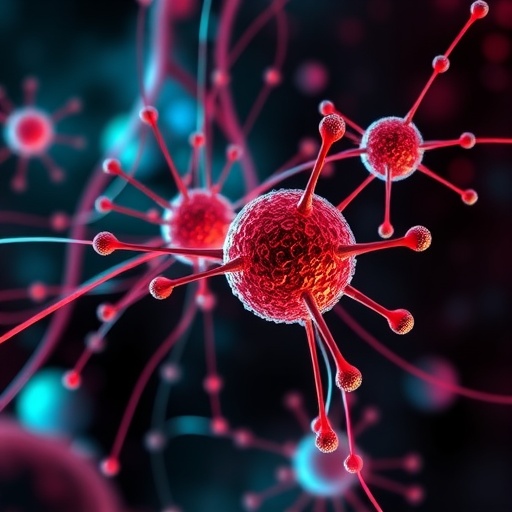In a groundbreaking advancement poised to redefine the landscape of proteomics and liquid biopsy, researchers led by Wu, Tsantilas, and Park have unveiled a novel methodology for enriching extracellular vesicles (EVs) from plasma samples, leveraging an innovative technology called Mag-Net. Published in Nature Communications, this study not only introduces a highly efficient approach to isolate these microscopic carriers but also underpins their potential to transform the analytical depth and accuracy of plasma proteome profiling in clinical and research settings.
Extracellular vesicles are nano-sized particles secreted by cells, encapsulating a rich cargo of proteins, nucleic acids, and other biomolecules reflective of their parent cells’ physiological state. Because of their ubiquitous presence in body fluids and their ability to mirror pathophysiological conditions, EVs have emerged as prime candidates for non-invasive biomarkers. However, the inherent heterogeneity and low abundance of EVs in plasma have historically complicated their isolation and downstream analysis.
The Mag-Net system addresses these longstanding challenges by utilizing a magnetic nanoassembly that selectively binds to EV membranes, enabling their rapid and efficient capture directly from plasma. This magnetic enrichment circumvents the extensive centrifugation and filtration steps traditionally required, dramatically reducing sample processing time while preserving vesicle integrity. The implications for this are profound, as it allows researchers to retrieve high-purity EV populations suitable for detailed proteomic characterization.
.adsslot_XEfStGoOub{ width:728px !important; height:90px !important; }
@media (max-width:1199px) { .adsslot_XEfStGoOub{ width:468px !important; height:60px !important; } }
@media (max-width:767px) { .adsslot_XEfStGoOub{ width:320px !important; height:50px !important; } }
ADVERTISEMENT
Technically, the Mag-Net platform is constructed from core-shell magnetic nanoparticles functionalized with ligands exhibiting strong affinity for phospholipid membranes characteristic of EVs. This design enables selective magnetophoretic separation, ensuring minimal contamination from free plasma proteins and lipoproteins. Moreover, the modular architecture of Mag-Net supports scalability and integration with standard proteomic workflows, including mass spectrometry and affinity-based assays.
The authors meticulously validated their technology using plasma samples from healthy donors and disease cohorts, demonstrating significantly higher EV yield and purity compared to ultracentrifugation and polymer-based precipitation methods. Proteomic profiling revealed a richer repertoire of vesicle-associated proteins, uncovering subtle variations linked to pathological states. Such precision facilitates the discovery of novel biomarkers and enhances the robustness of diagnostic assays relying on plasma-derived vesicles.
Beyond analytical performance, the Mag-Net platform exhibits notable compatibility with downstream molecular analyses. The preserved integrity of vesicular cargo enables multi-omics approaches, combining proteomics with nucleic acid profiling to decode the complex functional landscape of circulating EVs. This integrative capability is particularly relevant for early disease detection and monitoring responses to therapy, where comprehensive molecular characterization is essential.
One captivating aspect of the study is the potential application of Mag-Net in personalized medicine. As EVs encapsulate molecular fingerprints from individual cells, their enriched analysis could guide tailored therapeutic interventions by accurately reflecting tumor heterogeneity or immune system dynamics. The rapidity and reliability of the enrichment method imply that clinical laboratories might soon incorporate EV-based assays into routine diagnostics.
Moreover, the improved scalability and reproducibility of Mag-Net hold promising prospects for large cohort studies and biobanking efforts. High-throughput isolation of EVs with consistent quality standards will facilitate expansive proteomic databases, accelerating biomarker validation and expanding our molecular understanding of diseases on a population level. This democratization of plasma EV analysis could pioneer a new era in precision health surveillance.
Mag-Net’s innovative approach also surmounts critical technical hurdles such as sample volume requirements and vesicle loss, enabling effective isolation from small plasma aliquots common in clinical contexts. This feature is vital for pediatric patients and longitudinal studies where sample conservation is crucial. The minimal sample manipulation mitigates degradation or alteration of vesicle content, ensuring data fidelity and reproducibility.
From a mechanistic standpoint, the investigators provided in-depth characterization of the magnetic binding kinetics and specificity, detailing how the engineered nanoparticle surface chemistry selectively discriminates EVs from similar nanoscale contaminants. These insights lay the groundwork for future optimization and adaptation of the technology to isolate subpopulations of vesicles based on origin or disease-specific surface markers.
The implications of this advancement extend into fields such as infectious disease and neurodegeneration, where liquid biopsy approaches face significant challenges due to low biomarker abundance and complex biofluid backgrounds. Mag-Net’s ability to capture disease-relevant EVs efficiently opens avenues for earlier diagnosis and real-time monitoring of disease progression in conditions ranging from viral infections to Alzheimer’s disease.
Furthermore, as the EV research community continues to expand, standardized and reproducible methods for vesicle isolation become paramount. The Mag-Net technique addresses this critical need by combining operational simplicity with technical rigor, potentially becoming a benchmark protocol for researchers and clinicians alike. Such standardization is essential for translating laboratory discoveries into clinical applications and regulatory approval processes.
The study’s comprehensive proteomic analysis uncovered novel protein markers enriched in disease states, providing new candidates for biomarker panels that can enhance the specificity of diagnostic tests. The authors envision integrating Mag-Net enriched EV analysis with artificial intelligence algorithms to develop predictive models for patient stratification and outcome prediction, leveraging high-dimensional proteomic data.
In conclusion, the development of Mag-Net marks an evolutionary leap in extracellular vesicle isolation technology, enhancing the analytical capabilities of plasma proteomics. By combining magnetic nanotechnology with meticulous biochemical engineering, Wu and colleagues have forged a platform that promises to accelerate biomarker discovery, propel precision medicine, and deepen our understanding of cell-to-cell communication through the vesicular secretome. As this technology gains adoption, it is poised to catalyze a paradigm shift in non-invasive diagnostics and therapeutic monitoring, offering hope for earlier detection and improved management of complex diseases.
Subject of Research: Enrichment and analysis of extracellular vesicles for plasma proteomics.
Article Title: Enrichment of extracellular vesicles using Mag-Net for the analysis of the plasma proteome.
Article References:
Wu, C.C., Tsantilas, K.A., Park, J. et al. Enrichment of extracellular vesicles using Mag-Net for the analysis of the plasma proteome.
Nat Commun 16, 5447 (2025). https://doi.org/10.1038/s41467-025-60595-7
Image Credits: AI Generated
Tags: advancements in extracellular vesicle researchchallenges in EV analysis from plasmaclinical applications of extracellular vesiclesenhancing analytical depth in proteomicsextracellular vesicle isolation techniquesimproving sample processing in proteomicsMag-Net technology for proteomicsmagnetic nanoassembly for EV capturenon-invasive biomarkers in liquid biopsynovel methodologies in biomarker discoveryplasma proteome profiling innovationsrevolutionary methods in liquid biopsy





